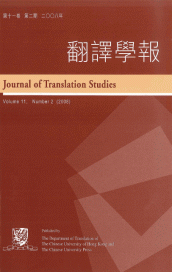 |
|
|||||||||||||||||||||||||||||||||||||||||||||||||||||||||||||||||||||||||||||||||||||||||||||
| Overcoming Prejudice: On Translating Hong Kong Popular Fiction |
|---|
| Roberta Raine |
|
Hong Kong popular fiction is an area of study that is often overlooked by both translation scholars and practicing translators. There are a number of reasons for this, chief among them being the disdain toward popular fiction frequently found in both academia and the literary world. This paper challenges this attitude, as it often causes translators to ignore the very real value that can be found in popular narratives. The paper begins with an overview of Western and Chinese scholarly writing on how to distinguish popular fiction from "high" or "elite" fiction. Arguments from the fields of popular culture studies and sociology are presented to support the contention that popular narratives can serve as valuable diagnostic tools for studying a society’s attitudes and beliefs. The concept of “worthiness” in translation is then discussed, drawing upon Steiner’s theory of the hermeneutic motion and other sources to examine what (or who) determines whether or not a given work is “worthy” of translation. Such a determination must be based on the interests and needs of the target-language audience, needs which will, by definition, be different to those of the source-language audience. It is argued that translators must avoid falling prey to prejudice against popular fiction if they are to serve their readers and to help preserve the full scope of Hong Kong's literary heritage. |
| Visualization and Gary Snyder's Translation of Cold Mountain Poems |
|---|
| Joan Qionglin Tan |
|
Visualization is Gary Snyder's unique translation method used in translating the Tang hermit-poet Han Shan's poems. This consists of four steps: remembering, visualizing, writing and checking, and it emphasizes a visual process of the mind, which is very similar to Ezra Pound’s translation principle of phanopoeia and Snyder’s own poetic production method. The mastery of visualization makes a translated poem sound like an English poem, although some distortions are inevitable in the translation process because of the reworking. Thus, selection and adaptation principles appear to be more important for a translator before and after the visual activities in his mind and it is these which largely determine the quality of translation. This article thoroughly examines Snyder's twenty-four translations of the Cold Mountain poems, and compares them with Arthur Waley's translations. It demonstrates that Snyder's success is not separate from his personality, cultural taste and mountain experiences influencing his visualization. Snyder's direct treatment of diction, style and form is in accordance with Han Shan's vernacular language and Chinese Chan poetic aesthetics. His selection and adaptation principles present Han Shan as an old mountain hermit in self-forgotten joy on Cold Mountain, a place of seclusion which becomes synonymous with Chan enlightenment. With regard to Snyder's inaccuracies, three aspects should be considered: first, errors caused by his misunderstanding of the original; second, deliberate naturalization of exotic terms; and third, unconscious replacement of the Chinese mountain scenery with his American wilderness. Therefore, the article contends that while Snyder's visualization provides a good paradigm for some poet-translators, it is not a method to be followed by all translators. |
| 母語中文與母語英文譯者中譯英謂語動詞時體選擇之比較分析 |
|---|
| 董大暉 |
|
譯者在從母語譯入第二語的過程中,往往會出現時體誤用的問題。引起這種問題的原因頗多,本研究僅探討母語是中文的譯者在中譯英社論文章時,謂語動詞時體的選擇、中文原文時體、中文原文時體的表達方式、中文原文語篇結構以及譯者翻譯能力等多重因素之間的關係。本研究採用語料庫的量化研究方法,透過資料收集,獲取一百二十七篇譯文,原文皆為經貿領域社論型文章,譯文由母語是中文和母語是英文的有經驗譯者以及母語是中文無經驗譯者三類譯者所翻譯。在建立中英平行語料庫(parallel corpus)之後,本研究使用統計學「最適尺度法」進行分析。研究結果顯示,母語是英文的譯者與母語是中文的譯者,時體選擇都有跟隨原文的趨勢,而且譯者對時體的選擇似乎不受原文語篇結構的影響。母語是英文的譯者對原文時體的改變多集中於中文具明顯標記的「過去時」,而母語是中文的譯者對中文原文時體的改變,則無任何規律可循。母語中文譯者時體選擇上問題,似乎是由缺乏對英語時體語篇層面上用法的認知所造成,這是母語中文譯者亟需增強之處。 |
| 《意拾喻言》考述 |
|---|
| 王輝 |
|
一八四零年印行的《意拾喻言》是近代最早的《伊索寓言》漢譯本,在十九世紀廣為流傳,進入二十世紀卻湮沒無聞。本文借助大量一手中英文文獻,考述《意拾喻言》的譯者、源流和傳播情況,澄清學界的一些誤解,並結合這一譯本的「漢化」特色,分析其成功之處。 |
| 政治與文學的角力:論晚清《魯濱孫飄流記》中譯本 |
|---|
| 崔文東 |
|
本文選取晚清三部《魯濱孫飄流記》中譯本為研究對象,試圖突破意譯、歸化等籠統評價,在歷史語境中考察晚清譯者翻譯目的,翻譯策略與翻譯規範的關係。三部譯本的譯者同為救亡圖存而譯書,旨在教育大眾,為此改寫原著,迎合讀者,引導讀者。由於譯者對政治與文學的關注程度不同,政治立場、詩學觀各異,譯本面貌大相逕庭。雖然三部譯本均可視為歸化翻譯,但都起到思想啟蒙的作用,衝擊了傳統價值觀;雖然同是意譯,但林紓的翻譯再現了原著的詩學特徵,推動了中國文學的革新。 |
| 雜合化:譯者主體性在強勢文化與弱勢文化裏的操縱 |
|---|
| 裘禾敏 |
|
譯者主體性長期以來因被傳統翻譯研究「遮蔽」而處於邊緣化的地位,筆者試圖著力考察譯者主體性這一重要的研究對象,剖析譯者處於強勢文化與弱勢文化時如何採用「雜合化」的翻譯策略來影響、操縱甚至顛覆譯入語主流文學、文化與意識形態,闡明後殖民學者引入的「雜合化」概念是綜合、包容異質文化的折衷手段,旨在揭示譯者主體性在翻譯這個「後殖民語境的競技場與試驗場」的彰顯作用。 |
| 眾裏尋他千百度-「雙關語」英漢互譯的「動態層次策略觀」 |
|---|
| 董琇 |
|
雙關語中語音、語義特徵本身作為了信息內容加以傳達,而英漢屬非親屬語言,雙語間表層(音、形)缺乏意義的信息轉換通道,從而造成了雙關語英漢轉換的可譯性限度。本文從「雙關語」具有「雙」層相「關」意義的基本特徵出發,將雙關語的翻譯策略化歸為三個層次:一、通過對應雙關,忠實再現原雙關的表層、深層概念意義及其「關聯」,僅限於極少數的語義雙關。二、通過模仿採用相近雙關翻譯或在直譯的基礎上採用註釋點明原文雙關,譯文中仍然出現兩層意義及其關聯。三、捨棄關聯,僅分別譯出二義、或單譯表層意義或單譯深層意義。雙關翻譯是一個動態選擇策略的過程,同一譯者在不同時期,不同譯者在不同時期或同一時期都可能採取不同層次的策略對同一雙關進行處理。「動態層次策略觀」,強調以「動態模仿」、「功能代償」為核心,在「翻譯審美圖示」的四個平面(「觀覽」、「品味」、「領悟」和「再現」)上不斷推進,充分「移情」,實現「營造體驗」,採用整體處理法,通過概念結構的遞迴式整合,調節詞音、詞性、詞序和詞義的關係,啟動聯想機制,實現兩種不同語言的概念結構系統的轉軌,擴大不同語言之間信息轉化的通道,以使譯文達到形式和意義的完美結合。 |



